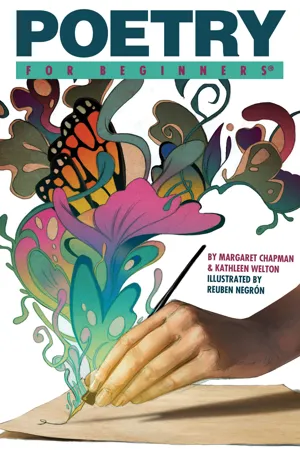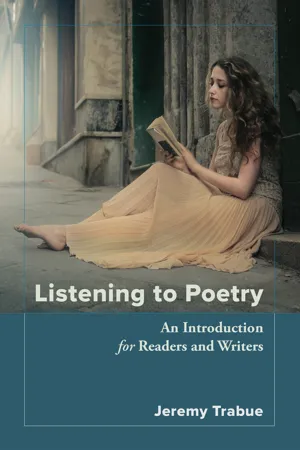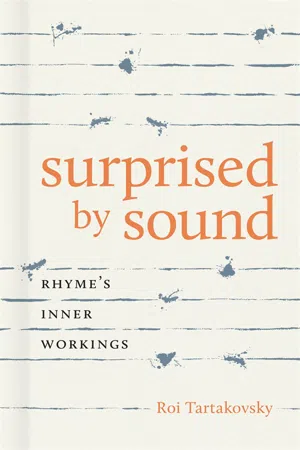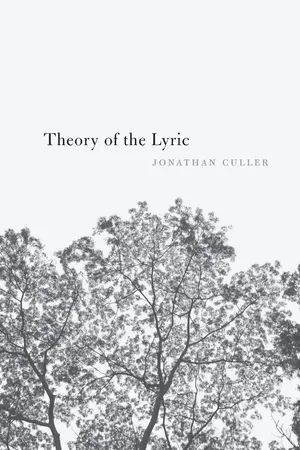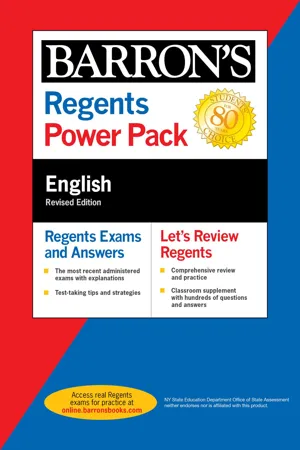Literature
Rhyme
Rhyme is the repetition of similar sounds at the end of lines in poetry or songs. It adds musicality and rhythm to the text, enhancing its aesthetic appeal and making it more memorable. Rhyme schemes can vary, such as AABB or ABAB, and can contribute to the overall structure and tone of a literary work.
Written by Perlego with AI-assistance
Related key terms
8 Key excerpts on "Rhyme"
- eBook - ePub
- Margaret Chapman, Kathleen Welton, Reuben Negrón(Authors)
- 2010(Publication Date)
- For Beginners(Publisher)
Every poem basically exists two ways—it exists on the page, and it exists read out loud. Some poems do better one way or another—concrete poetry and experimental poetry sometimes can't be read out loud. Other types of poems, especially poems that use Rhyme and rhythm, or play with the sound of language, might seem better when they are heard than when they are read.Many people think of Rhyme when they first think of poetry.The simple definition of Rhyme is when two or more words have the same ending sound. Rhymes sometimes have the same written ending, but because English spelling is all over the place, often words Rhyme even if they look completely different.For example: Ease Breeze Orange Blorenge (a place in Wales) Rhyme is a little more complicated than just the same ending sound - there are two sorts of Rhyme. Perfect Rhymes also have to have the same pattern of stress on the syllables. For example: Beautiful DutifulAnother common type of Rhyme in poetry is slant Rhyme. Slant Rhyme is when words sound similar, but don't actually Rhyme. Slant Rhyme actually encompasses a few different literary techniques, including half Rhyme, when the final consonant sounds match, consonance, when most of the consonant sounds match, assonance, when just the vowel sounds match, and sometimes even alliteration - eBook - ePub
Listening to Poetry
An Introduction for Readers and Writers
- Jeremy Trabue(Author)
- 2019(Publication Date)
- Chemeketa Press(Publisher)
At the other extreme, there are also many people who think of nonrhyming poetry as “modern” and rhyming poetry as “traditional.” This is also inaccurate. Old English poetry did not Rhyme at all, nor did much poetry in Middle English. UnRhymed verse has been part of modern English right from the beginning. Seventeenth-century poet John Milton wrote a blistering attack on Rhyme in his introduction to Paradise Lost (which does not Rhyme). And most early English dramatic verse is mostly written without any Rhyme (though some short rhyming passages do appear in Shakespeare and other renaissance drama).The role and importance of Rhyme in poetry was much debated and contested in Milton’s time, and it still is today. UnRhymed poetry is more common, but rhyming poetry is alive and well. Rhyme is not omnipotent or omnipresent. Rhyme does not define “poem.” However, it is a part of poetry, and it’s here to stay.Rhyme is one of those subjects for which the phrase “deceptively simple” was created. Most preschoolers recognize and can give examples of rhyming words. Most could easily recognize the Rhymes in this list:bed / embed / said / read bay / weigh / astray / they wing / asking / unifying / testifying lady / bee / abbey / tabbyBut what exactly makes these words “rhyming”? The entire ending syllable is not exactly the same in each one because the ending syllables may start with different consonant sounds. The spelling is certainly not the same in each one. However, the ending syllable after its initial con sonant sound is the same. Notice that they don’t have to have the same number of syllables, either, as long as that final syllable sound after its initial consonant is identical.Rhyme is the repetition of the same vowel sound followed by the same consonant sound—if there is one—in the final syllable of two or more words and in close enough proximity that it creates an obvious pattern. That’s the basic definition, but there is a lot of variation just under the surface of that definition that you should be aware of.Varieties of Rhyme
Rhyme is such a rich subject that there are different varieties of Rhyme.First, Rhymes can be either internal or end. End Rhyme occurs at the ends of lines, and is the most common.When people talk about Rhyme, they usually mean end Rhyme. Internal Rhyme, - No longer available |Learn more
- George Ehrenhaft(Author)
- 2023(Publication Date)
- Barrons Educational Services(Publisher)
Because a feature of any good poem is unity, its sounds cannot be separated from its themes, structure, imagery, and so forth. That’s why Rhyme, rhythm, the use of repetition, and each of several other sound-related techniques are more than abstractions. They are integral to a poem’s totality.TIP In poetry, the “sound must seem an echo to the sense.” —Alexander Pope, “An Essay on Criticism”Rhyme
Rhyme is perhaps the most easily recognized characteristic of poetry, particularly end Rhyme, the repetition of identical sounds at the end of successive lines, as illustrated by this excerpt from W. H. Auden’s “It’s No Use Raising a Shout”:Equally vivid end Rhymes may occur in alternating lines, as in this fragment of Lord Byron’s “She Walks in Beauty”:A long time ago I told my motherI was leaving home to find another:I never answered her letterBut I never found a betterHere am I, here are you:But what does it mean? What are we going to do?Another common rhyming pattern consists of end Rhymes in only the second and fourth lines of a four-line stanza, illustrated in the anonymously written “The Dying Airman”:She walks in beauty like the nightOf cloudless climes and starry skiesAnd all that’s best of dark and brightMeet in her aspect and her eyes:Take the cylinders out of my kidneys,The connecting-rod out of my brain,Take the cam-shaft out of my backbone,And assemble the engine again.Types of Rhymes
Customarily, Rhyme is produced by one syllable words (fat/cat) or by the final syllables of multisyllabic words (prevail/entail; disclosure/composure).Sounds that are close but not exact duplicates of one another are called, among other things, slant Rhymes, off Rhymes, and near Rhymes (seen/been; ill/all; summer/somewhere - Editors of REA(Author)
- 2012(Publication Date)
- Research & Education Association(Publisher)
The most common is the end Rhyme, which has the rhyming word at the end of the line, bringing the line to a definite stop but setting up for a rhyming word in another line later on, as in “Stanzas”: home… Rome, a perfect Rhyme. Internal Rhyme includes at least one rhyming word within the line, often for the purpose of speeding the rhythm or making it linger. Look at the effect of Byron’s internal Rhymes mixed with half-Rhymes: “combat… for that”; “Can/And… hanged” slowing the rhythm, making the reader dwell on the harsh long “a” sound, prolonging the sneer which almost becomes a snarl of anger. Slant Rhyme, sometimes referred to as half, off, near, or approximate Rhyme, often jolts a reader who expects a perfect Rhyme; poets thus use such a Rhyme to express disappointment or a deliberate let-down. Masculine Rhyme uses one-syllable words or stresses the final syllable of polysyllabic words, giving the feeling of strength and impact. Feminine Rhyme uses a Rhyme of two or more syllables, the stress not falling upon the last syllable, giving a feeling of softness and lightness. One can see that these terms for Rhyme were written in a less enlightened age! The terms themselves for the Rhymes are less important than realizing or at least appreciating the effects of the Rhymes. If the lines from “Stanzas” had been unRhymed and varying in metrical pattern, the verse would have been termed free, or to use the French term, “Vers libre,” not to be confused with blank verse, which is also unRhymed but has a strict rhythm. The Elizabethan poets Wyatt and Surrey introduced blank verse, which Shakespeare uses to such good effect in his plays, and later, Milton in the great English epic Paradise Lost. Free verse has become associated with “modern” poetry, often adding to its so-called obscurity because without Rhyme and rhythm, poets often resort to complicated syntactical patterns, repeated phrases, awkward cadences, and parallelism- eBook - ePub
Surprised by Sound
Rhyme's Inner Workings
- Roi Tartakovsky(Author)
- 2021(Publication Date)
- LSU Press(Publisher)
1 Hearing and Listening to Rhyme If negotiating with linguistic constraints and literary conventions comes with the territory of writing poetry, Rhyme occupies a great part of that territory. Certainly, in the case of English, it is difficult to overstate the association between Rhyme and poetry, or the significance of Rhyme to poetry. This association is attested to in rhetoric by Rhyme’s synecdochic or metonymic substitution for poetry itself. Rhyme-as-poem is a prevalent trope throughout much English-language poetry and is nowhere more evident than in William Shakespeare’s ending of Sonnet 17: “You should live twice, in it and in my Rhyme.” In practice, Rhyme’s prevalence is attested to by the overwhelming number of Rhymed poems written by generations of poets. Of course, Rhyme is not the only sound device, nor the earliest in the history of English poetry. A perfect or full Rhyme is, in fact, one of numerous poetic sound devices, including assonance, alliteration, consonance, and many forms of partial Rhymes. But it is the more encompassing member among most of these weaker or partial sound relations because full Rhyme typically requires a correspondence of both the vowel and the following consonant sounds of the last stressed syllable of each word. 1 Assonance was never used systematically in English verse, partial Rhyme is best appreciated as a subset of full Rhyme, and alliteration, while carrying its own historical connotations of Anglo-Saxon prosody, seems, at least in poetic consciousness, more distant and dimmed today than Rhyme. 2 Rhyme, both historically and phonetically, is set up to stand out in the soundscape of the poem or of poetry. As prevalent as Rhyme is (or was —a question I will get to momentarily), it is easy to forget that Rhyme’s entry into English poetry was a gradual process and one that—in spite of scholarly interest—remains somewhat murky. Murkier yet is the larger question of the historical origin of Rhyme itself - eBook - ePub
The Princeton Encyclopedia of Poetry and Poetics
Fourth Edition
- Stephen Cushman, Clare Cavanagh, Jahan Ramazani, Paul Rouzer, Stephen Cushman, Clare Cavanagh, Jahan Ramazani, Paul Rouzer, Stephen Cushman, Clare Cavanagh, Jahan Ramazani, Paul Rouzer(Authors)
- 2012(Publication Date)
- Princeton University Press(Publisher)
enterprise . This is Rhyme yet more interwoven and complete.(8) By participation of the Rhymes in sound patterning nearby . Part of the perceived effect of the Rhyme also depends on the density of sound patterning in the lines surrounding the Rhyme words. Here we enter the realm of those larger constellations of sound that schematize the entire poem, over and above, though not apart from, the Rhyme scheme. Like Rhyme, these too impose a surplus of design on the verbal material, binding words together, promoting salient words, underlining significant semantic parallels between otherwise disparate words, punctuating the seriatim flow of text processing by repetition of significant sounds recently heard and remembered, and marking the text as aesthetic through the increase of attention required—and rewarded—in reading.(9) By the position in the line of the Rhymes. Normally Rhyme is presumed to be end Rhyme, i.e., sound linkage of lines by marking their ends (it is known that ends of members in series have special cognitive “visibility”), but more complex forms Rhyme the word at line end with other words line-internally or Rhyme two line-internal words in the same or successive lines, or both, thus opening up a spectrum of new possibilities for more complex sound figuration. Further, even the end-Rhyme word itself may be hyphenated or broken over the line end to effect the Rhyme (see BROKEN Rhyme ).(10) By the interval between the Rhymes. Without the space or gap between the Rhyme words, no Rhyme is possible: hence, the distance is no less significant than the repetition. In fact, repetition requires distance, the absence enabling the presence. The variance of distancing and of repetitions, of course, yields the patterning of Rhyme in the stanza, i.e., the Rhyme scheme; more interestingly, it also enables the distinction between “nonRhymes” and “antiRhymes.” Abernathy points out that it is not sufficient to characterize some types of verse as “unRhymed,” for this fails to distinguish between “Rhymeless” verse, wherein Rhyme is neither required nor prohibited but merely unspecified, and “antiRhymed” verse, such as blank verse, where Rhyme is specifically proscribed. Rhyme schemes reveal intervals not only between Rhymes but between unRhymed lines; and in some unRhymed verse, passages of deliberate Rhyme may even appear (T. S. Eliot). It is also worth noting that Rhymes that are very widely separated are not Rhymes because they are not perceived so. There are, in fact, some hundred-odd Rhymes in Paradise Lost - eBook - ePub
- Jonathan Culler(Author)
- 2015(Publication Date)
- Harvard University Press(Publisher)
FOURRhythm and RepetitionRoman Jakobson defines the poetic function of language as “the projection of the principle of equivalence from the axis of selection onto the axis of combination,” so that “equivalence becomes the constitutive device of the sequence.” That is, items are chosen for combination in sequence because they are in various respects equivalent and thus produce a rhythm of repetition with variation. The poetic function, of course, is not confined to poetry: Jakobson’s most striking example is the political slogan “I like Ike,” where the same vowel is repeated three times, two of the three words Rhyme, and I is included in both Ike and like, “a paronomastic image of the loving subject enveloped by the beloved object.”1 Set off as a slogan, its three stressed vowels give it a chant-like rhythm that makes it enviably compelling.Poetry, for Jakobson, is where this poetic function becomes the “dominant, determining function.” In the Anatomy of Criticism, Northrop Frye introduces the discussion of lyric by citing a line of verse from Shakespeare’s Measure for Measure:Ay, but to die, and go we know not where:We can hear of course the metrical rhythm, an iambic pentameter spoken as a four-stress line. We can hear the semantic or prose rhythm, and we hear what we may call the rhythm of decorum, the verbal representation of a man facing the horror of death. But we can also, if we listen to the line very attentively, hear another rhythm in it, an oracular, meditative, irregular, unpredictable, and essentially discontinuous rhythm, emerging from the coincidences of the sound pattern:Just as the semantic rhythm is the initiative of prose, and the metrical rhythm is the initiative of epos, so this oracular rhythm seems to be the predominating rhythm of lyric.2Frye’s procedure here highlights the difficulties of discussing lyric rhythm. In order to distinguish the rhythm of lyric from that of epic or narrative poetry, he takes a verse from a play (though he says he is taking a line of poetry “at random”), breaks up the ten-syllable metrical line, and arranges the fragments as a kind of free verse, with shorter lines that highlight Rhymes—this to create a lyric rhythm, which he calls “associative” and “oracular.” Since he knows full well that many lyrics use a regular meter of long lines, and that internal Rhymes and other kinds of sound patterning are found in narrative and epic verse as well, Frye’s formulations suggest that thinking about lyric rhythms involves hearing differently, attending to sorts of patterning that might not compel attention in narrative poetry. The associative rhythm involves “paranomasia, sound-links, ambiguous sense-links, and memory-links.”3 - eBook - ePub
- Carol Chaitkin(Author)
- 2021(Publication Date)
- Barrons Educational Services(Publisher)
page 81 ) create the effect of internal Rhyme.- irony In general, a tone or figure of speech in which there is a discrep-ancy—(a striking difference or contradiction)—between what is expressed and what is meant or expected. Irony may be used to achieve a powerful effect indirectly. In satire, for example, it may be used to ridicule or criticize. Stephen Crane’s poem “Do Not Weep, Maiden, for War Is Kind” (page 88 ) is intensely ironic, both in the stanzas apparently seeking to comfort those whose lovers, fathers, and sons have died and in the contrasting stanzas of apparent celebration of the glories of war. We also speak of dramatic irony in fiction in which the reader understands more than the characters do. Ring Lardner’s short story “Haircut” is an excellent example.
- lyric A general term used to describe poems that are relatively brief and expressed in the voice of a single speaker (narrative voice). Lyric poems express a powerful emotion revealed in a significant experience or observation. (See discussion on page 78 .)
- metaphor A form of analogy. Through metaphor, a poet discovers and expresses a similarity between dissimilar things. The poet use metaphors to imaginatively find common qualities between things we would not normally or literally compare. As a figure of speech, metaphor is said to be implicit or indirect. This contrasts to simile (see page 98 ), where the comparison is expressed directly. In his final soliloquy, Macbeth uses a series of metaphors to express the meaninglessness of his own life: “Life’s but a walking shadow, a poor player . . . it is a tale told by an idiot . . . .”
- meter and rhythm Rhythm refers to the pattern of movement in a poem. As music has rhythm, so does poetry. Meter refers to specific patterns of stressed and unstressed syllables. See iambic pentameter
Index pages curate the most relevant extracts from our library of academic textbooks. They’ve been created using an in-house natural language model (NLM), each adding context and meaning to key research topics.
